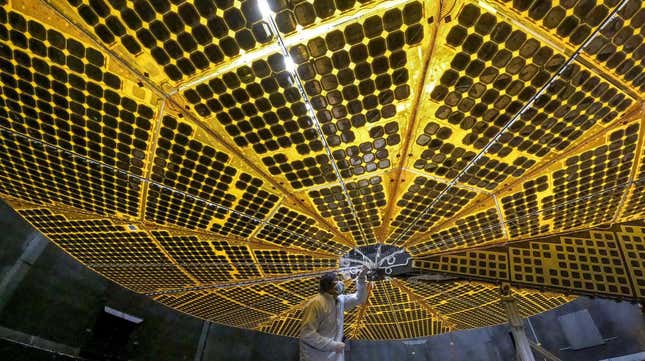
Just a few hours into its 12-year journey to Jupiter’s Trojan asteroids, the Lucy spacecraft ran into a problem. One of its solar arrays refused to fully open and mission controllers have been working on the problem ever since. There’s good news to report, however, as the team appears to have made a breakthrough.
Since Lucy’s launch in October 2021, NASA engineers have been attempting to fully open and latch the spacecraft’s stubborn solar array. After seven trials, the solar array is now between 353 degrees and 357 degrees open out of a full 360 degrees. It’s still not a perfect circle, but NASA says this configuration is good enough for Lucy to carry on with its mission.
Lucy is tasked with an unprecedented mission to explore the Trojan asteroids, two groups of rocky bodies that lead and follow Jupiter as it orbits the Sun. In order to survive its long journey through space, Lucy is equipped with two massive solar arrays on either side, each spanning 22-feet wide (7 meters). The arrays were tucked in during Lucy’s initial ride to space on board an Atlas V rocket and designed to later unfurl like a pair of massive hand fans. During deployment, however, one of Lucy’s solar arrays got stuck at 347 degrees. Ground controllers worried that the array would be further damaged when it came time for the spacecraft to fire its main engine.
Lucy’s anomaly response team came together within hours of the malfunction, working together to come up with a plan. “We have an incredibly talented team, but it was important to give them time to figure out what happened and how to move forward,” Hal Levison, Lucy’s principal investigator from Southwest Research Institute, said in a statement. “Fortunately, the spacecraft was where it was supposed to be, functioning nominally, and—most importantly—safe. We had time.”
The team brainstormed together for months and finally came up with two possible solutions: Either keep the array at 347 degrees or start pulling on the array’s lanyard by using the spacecraft’s backup motor. But team members had to first assess the risks associated with both options and proceed accordingly. They constructed a replica of the backup motor and tested the replica beyond its limit on the ground to see how it would handle the unfurling efforts in space.
Following months of running simulations, NASA decided that it would attempt to fully deploy Lucy’s arrays through a series of intricate maneuvers and commands sent over to the spacecraft while it was 60 million miles (96 million kilometers) away from Earth.
On May 9, mission control commanded Lucy to deploy the array, running its primary and backup motors simultaneously for a series of short intervals to avoid overheating. The team then paused to analyze the data before a second attempt on May 12, when the same commands were transmitted again. After seven trials of pulling the lanyard during the months of May and June, Lucy’s solar array is now between 353 degrees and 357 degrees open. “While the array is not fully latched, it is under substantially more tension, making it stable enough for the spacecraft to operate as needed for mission operations,” NASA wrote in a statement.
Lucy is gearing up for its first gravity assist in October 2022, where it will fly past Earth in order to use the planet’s gravity to pull on the spacecraft, thereby changing its orbital trajectory beyond the orbit of Mars. We’re rooting for you, Lucy. Even if your array is a few degrees off.
More: Debris From China’s Uncontrolled Rocket Crashed Near Populated Areas.